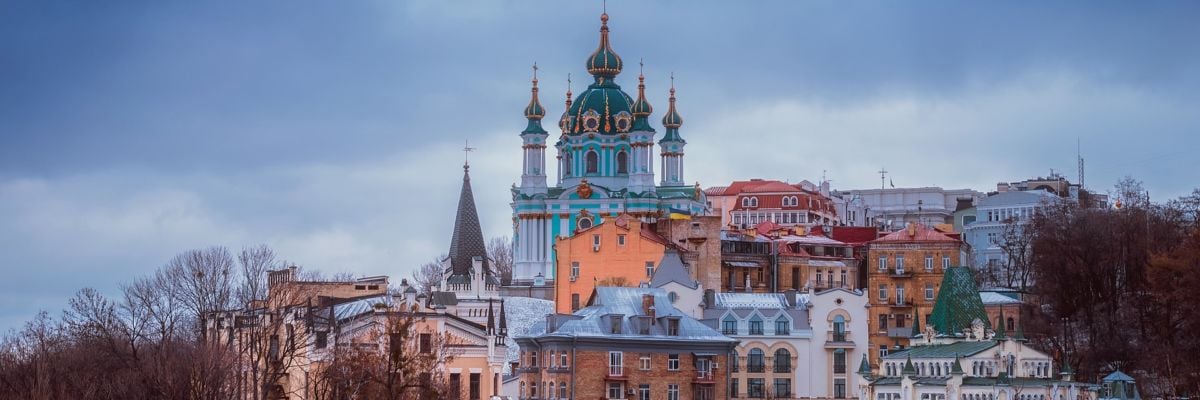
If you are a Catholic and have spent at least one minute scrolling through social media, then odds are you encountered some form of church gossip, accompanied by a screed of complaints about the bishops, and especially the bishop of Rome. In my experience, the slow trickling effect of encountering such toxic rants, especially after long term exposure, is taxing on the soul. It also tempts disaffected Catholics to search for greener pastures.
For reasons like these, many are discerning Eastern Orthodoxy as an alternative to the Catholic Church. But there’s a problem: which Orthodox church should they join?
It’s not an idle question of taste. The Eastern Orthodox churches are currently experiencing a significant internal schism over the ecclesial status of the same newly war-afflicted nation now dominating headlines the world over: Ukraine. In this article, we will briefly examine the state of the schism, as well as how it relates to the current war in Ukraine. In short, for a fair discernment of Orthodoxy to be made, the rose-colored glasses have to go.
To properly understand the state of the schism within Orthodoxy, it is important first to consider what constitutes a schism. For Catholics, schism is “the refusal of submission to the Roman pontiff or of communion with the members of the Church subject to him” (Catechism of the Catholic Church 2089). But for Orthodox, it is a little more complicated.
One of the difficulties when discussing this topic is that Orthodoxy lacks an objective definition for schism. Some Orthodox define it as “the refusal of certain people to be in obedience to lawful hierarchy,” but this definition begs the question, since the identification of lawful hierarchy is often what is in dispute in church divisions. There is an objective nature to the Catholic definition, since it centers on communion with an individual person: the bishop of Rome. However, the Orthodox definition above is more fluid, since the lawful hierarchy are not objectively identified, but are rather assumed.
This is partly the difficulty behind determining who separated from whom in the current schism between the patriarch of Moscow and the patriarchs of Constantinople and Alexandria. Moscow claims that Constantinople and Alexandria have severed themselves from the Orthodox Church, whereas Constantinople and Alexandria see Moscow as creating division in the Orthodox body. Who is to say which position is right when there is no objective standard by which to determine what is schismatic? Orthodoxy does not have an objective answer to this question.
What exactly are the reasons for the current schism in Orthodoxy? They revolve around who has the authority to grant autocephaly. An autocephalous church is a church that does not depend on any other church for its mission. In January of 2019, Bartholomew, the patriarch of Constantinople (also known as the ecumenical patriarch and the head of the Greek Orthodox), granted autocephaly to a group of Ukrainian clerics, which formed the Orthodox Church of Ukraine. This raised the ire of Kirill, the patriarch of Moscow (head of the Russian Orthodox), who maintains that the territory of Ukraine, and the Ukrainian Orthodox Church within it, is under his jurisdiction. (For the purposes of this controversy, the Ukrainian Orthodox Church and the Orthodox Church of Ukraine are discrete entities.) Kirill also maintains that his church, Ukraine’s alleged mother church, must consent to a grant of autocephaly, and this must be followed by a consensus of the other Orthodox churches. Only then can a declaration of autocephaly be issued. This is different from Bartholomew’s view, which is that Ukraine is Constantinople’s spiritual daughter and that he has the unilateral ability to grant Ukrainian autocephaly.
Needless to say, there is a lack of consensus among the Orthodox on how autocephaly is granted, since the ecumenical councils do not prescribe a specific procedure. To rub salt in the wound, the Council at Crete in 2016, which was nearly a hundred years in the making, was to settle the issue of how autocephaly is granted, but it failed to do so. So here we are.
Patriarch Bartholomew’s tomos (Greek, essentially a major announcement) that granted autocepaly to the Orthodox Church of Ukraine was quickly followed by a denunciation on part of Patriarch Kirill, along with the accusation that Bartholomew is in schism because “he received communion with schismatics.” The two patriarchs then ceased sharing Holy Communion.
Such was the lay of the land until recently. Although Theodoros II, the patriarch of Alexandria (formally “His Divine Beatitude the Pope and Patriarch of the Great City of Alexandria, Libya, Pentapolis, Ethiopia, All Egypt and All Africa, Father of Fathers, Pastor of Pastors, Prelate of Prelates, the Thirteenth of the Apostles and Judge of the Universe), was once in support of Kirill’s Ukrainian Orthodox Church, he later celebrated the liturgy with the primate of the Orthodox Church of Ukraine, Epiphany Dumenko, in August last year. Kirill immediately named Patriarch Theodore a schismatic and broke off communion with him, too. Thus, the Patriarch of Moscow no longer considers the Patriarchates of Constantinople and Alexandria as belonging to the Orthodox Church.
And that’s not all. A group of over a hundred priests under the patriarch of Alexandria objected to Theodore’s actions and petitioned Kirill to transfer their parishes to be under the patriarch of Moscow, without Theodore’s blessing. In December, Kirill established a patriarchal exarchate of Africa, which is another way of saying he created a parallel church in Theodore’s territory. Moscow then sent priests to Africa to oversee this endeavor, and they performed divine liturgies in Alexandria’s territory without Theodore’s permission. Consequently, on February 25, Theodore defrocked two priests of the Church of Russia who performed divine liturgies in his territory without his permission. Russia naturally claims that Theodore does not have the authority to judge its priests and has thumbed its nose at Theodore. Each party appeals to canon law and claims that the other party is operating out of bounds. The chaos continues to unfold as the days go by.
How does this all relate to the invasion of Ukraine by Russia on February 24? Putting the political aspects of this war to the side, Russia’s “religious war” highly favors Patriarch Kirill’s position, which may contribute to why Kirill has refrained from denouncing Vladimir Putin, the Russian president. After all, if Russia controls Ukraine, then Ukraine’s churches will be under Kirill, and Bartholomew’s Orthodox Church of Ukraine will disappear. This is not to say that Bartholomew and Theodore would immediately be back in Kirill’s good graces, but he would have little reason to insist on a long-term severance of communion between their churches with Ukraine entirely under his ecclesial auspices. That being said, the theological questions of what schism is and who can grant autocephaly would loom in the background until a future event brings them back to the forefront.
Some will still don their rose-colored glasses and claim “this is fine” as the entire house around them burns. However, should schism be dismissed as inconsequential? Metropolitan Agafangel of Odessa wrote to the patriarch of Alexandria in 2019, warning him that “schism is not washed away even by martyr’s blood,” and several hierarchs have called for a pan-Orthodox synod to resolve the schism’s “unfortunate consequences.” If schism is inconsequential, it appears that these high-ranking Orthodox didn’t get the memo.
Though Catholics are in no position to be triumphalist with all of the Church’s problems, Catholicism is able to offer a solution to this crisis in Orthodoxy. Orthodoxy lacks a source of unity and an authoritative structure to settle disputes in times of controversy. It is true that some Orthodox hold out that a pan-Orthodox synod can be called to settle such matters, yet questions like what constitutes a pan-Orthodox synod, who gets to vote, how many votes are required for a resolution to pass, and who will enforce its decisions remain hotly debated.
This is a perfect opportunity for the Orthodox to benefit from the See of Peter (i.e., Rome), which bishop Gasser at the First Vatican Council rightly called “the center of unity in the Church.” Even if Putin can subject the Ukrainian Christians under the patriarch of Moscow, at the expense of numerous innocent lives, the lack of unity among the Orthodox churches will remain. The Orthodox will still be in need of the gift of unity that Christ has given to his church through communion with St. Peter’s successor, the bishop of Rome. Perhaps it is time the Orthodox consider the one thing they haven’t conceived to solve their dispute: unity with the papacy.



